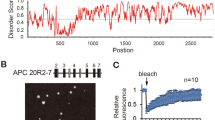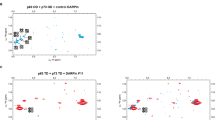Abstract
The tumor suppressor protein APC (Adenomatous Polyposis Coli) is localized in the cytosol and in the nucleus. In this study, we demonstrate that the nuclear APC protein level is high in cells in the basal crypt region of the normal colorectal epithelium. Strikingly, the APC protein staining resembles the staining pattern of a nuclear proliferation marker. As a first step towards a possible role of the nuclear APC protein, we provide data showing the direct interaction of the nuclear APC protein with DNA. A nuclear APC isoform precipitates with matrix-immobilized DNA. Vice versa, the immunoprecipitation of APC from nuclear lysates results in co-precipitation of genomic DNA. Using recombinant APC fragments we mapped three DNA binding domains: one within the β-catenin binding and regulatory domain, and two in the carboxyterminal third of the APC protein. All these three domains contain clusters of repetitive S(T)PXX sequence motifs that were described to mediate the DNA interaction of many other DNA binding proteins. In analogy to S(T)PXX proteins, the APC protein binds preferentially to A/T rich DNA sequences rather than to a single DNA sequence motif.
This is a preview of subscription content, access via your institution
Access options
Subscribe to this journal
Receive 50 print issues and online access
$259.00 per year
only $5.18 per issue
Buy this article
- Purchase on Springer Link
- Instant access to full article PDF
Prices may be subject to local taxes which are calculated during checkout








Similar content being viewed by others
References
Behrens J, Jerchow BA, Würtele M, Grimm J, Asbrand C, Wirtz R, Kühl M, Wedlich D and Birchmeier W. . 1998 Science 280: 596–599.
Behrens J, von Kries JP, Kuhl M, Bruhn M, Wedlich D, Grossschedl R and Birchmeier W. . 1996 Nature 382: 638–642.
Berman J, Eisenberg S and Tye BK. . 1987 Meth. Enzymol. 155: 528–537.
Blackwell TK and Weintraub H. . 1990 Science 258: 1104–1109.
Churchill ME and Suzuki M. . 1989 EMBO J. 8: 4189–4195.
Deka J, Kuhlmann J and Müller O. . 1998 Eur. J. Biochem. 253: 519–597.
de Pater S, Greco V, Pham K, Memelink J and Kijne J. . 1996 Nucl. Acid Res. 24: 4624–4631.
Gerdes J, Schwab U, Lemke H and Stein H. . 1983 Int. J. Cancer 31: 13–20.
Hart MJ, de los Santos R, Albert IN, Rubinfeld B and Polakis P. . 1998 Curr. Biol. 8: 573–581.
Heinen CD, Richardson D, White R and Groden J. . 1995 Cancer Res. 55: 4797–4799.
Kinzler KW and Vogelstein B. . 1996 Cell 87: 159–170.
Miyashiro I, Senda T, Matsumine A, Baeg GH, Kuroda T, Shimano T, Miura S, Noda T, Kobayashi S, Monden M, Toyoshima K and Akiyama T. . 1995 Oncogene 11: 89–96.
Molenaar M, van de Wetering M, Oosterwegel M, Petersen-Maduro J, Godsave S, Korinek V, Roose J, Destree O and Clevers H. . 1996 Cell 86: 391–399.
Munemitsu S, Albert I, Souza B, Rubinfeld B and Polakis P. . 1995 Proc. Natl. Acad. Sci. USA 92: 3046–3050.
Näthke IS, Adams CL, Polakis P, Sellin JH and Nelson WJ. . 1996 J. Cell Biol. 134: 165–179.
Neufeld KL and White RL. . 1997 Proc. Natl. Acad. Sci. USA 94: 3034–3039.
Polakis P. . 1997 Biochim. Biophys. Acta. 1332: 127–147.
Pyles RB, Santoro IM, Groden J and Paryseck LM. . 1998 Oncogene 16: 77–82.
Rebar EJ and Pabo CO. . 1994 Science 263: 671–673.
Rubinfeld B, Albert I, Porfiri E, Fiol C, Munemitsu S and Polakis P. . 1996 Science 272: 1023–1026.
Rubinfeld B, Robbins P, El-Gamil M, Albert I, Porfiri E and Polakis P. . 1997 Science 275: 1752–1753.
Rubinfeld B, Souza B, Albert I, Müller O, Chamberlain S, Masiarz FR, Munemitsu S and Polakis P. . 1993 Science 262: 1731–1734.
Stevens A and Lowe J (eds). . (1992). In: Histology. Gower Medical Publishing, London.
Su LK, Vogelstein B and Kinzler KW. . 1993 Science 262: 1734–1737.
Suzuki M. . 1998a J. Mol. Biol. 207: 61–84.
Suzuki M. . 1998b EMBO J. 8: 797–804.
Wong G, Müller O, Clark R, Conroy L, Moran MF, Polakis P and McCormick F. . 1992 Cell 69: 551–558.
Wong MH, Hermiston ML, Syder AJ and Gordon JI. . 1996 Proc. Natl. Acad. Sci. USA 93: 9588–9593.
Acknowledgements
We are indebted to Alfred Wittinghofer for fruitful discussions and continuous support. We thank Paul Polakis for providing the cDNA clone of the human full length APC gene. This work was supported by the Association for International Cancer Research, London (Grant 96-28). The work in the laboratory is supported by the Deutsche Forschungsgemeinschaft, the Bundesministerium für Bildung und Forschung, the Heinrich Hertz-Stiftung and Qiagen GmbH.
Author information
Authors and Affiliations
Rights and permissions
About this article
Cite this article
Deka, J., Herter, P., Sprenger-Haußels, M. et al. The APC protein binds to A/T rich DNA sequences. Oncogene 18, 5654–5661 (1999). https://doi.org/10.1038/sj.onc.1202944
Received:
Revised:
Accepted:
Published:
Issue Date:
DOI: https://doi.org/10.1038/sj.onc.1202944
Keywords
This article is cited by
-
Mechanisms Regulating Microtubule Binding, DNA Replication, and Apoptosis are Controlled by the Intestinal Tumor Suppressor APC
Current Colorectal Cancer Reports (2011)
-
Truncation mutations abolish chromatin-associated activities of adenomatous polyposis coli
Oncogene (2008)
-
Epithelial proliferation induces novel changes in APC expression
Oncogene (2005)
-
Interaction between Ku80 protein and a widely used antibody to adenomatous polyposis coli
British Journal of Cancer (2003)
-
Nuclear accumulation of full-length and truncated adenomatous polyposis coli protein in tumor cells depends on proliferation
Oncogene (2003)



